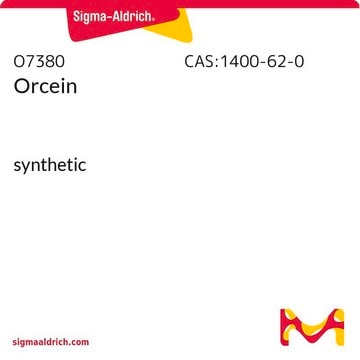Formulation 41325 contains carmine (1 g), aluminum chloride (0.5 g), and water (2 ml). On the other hand, the formulation for HT3018 consists of certified carmine (10 g/L), aluminum hydroxide (10 g/L), and aluminum chloride (5 g/L) in ethanol (50% w/v), following Southgate's modification of Mayer's mucicarmine procedure. Dilution instructions for use are provided, indicating the need to dilute product 41325 with either 10 volumes of distilled water or preferably 50-70% alcohol just before use.
41325
Mayer′s Mucicarmine Stain Solution
for microscopy
Sinónimos:
Mucicarmine Stain Solution according to Mayer
Seleccione un Tamaño
Seleccione un Tamaño
About This Item
Productos recomendados
grade
for microscopy
Quality Level
product line
BioChemika
form
liquid
shelf life
limited shelf life, expiry date on the label
technique(s)
microbe id | staining: suitable
application(s)
food and beverages
hematology
histology
storage temp.
room temp
suitability
fungi
General description
Components
Carmine 1 g, Aluminum chloride 0.5 g, water 2 ml
signalword
Danger
hcodes
Hazard Classifications
Eye Dam. 1 - Skin Corr. 1B
supp_hazards
Storage Class
8B - Non-combustible corrosive hazardous materials
wgk_germany
WGK 1
flash_point_f
Not applicable
flash_point_c
Not applicable
ppe
Faceshields, Gloves, Goggles, type ABEK (EN14387) respirator filter
Elija entre una de las versiones más recientes:
¿Ya tiene este producto?
Encuentre la documentación para los productos que ha comprado recientemente en la Biblioteca de documentos.
-
Please provide the protocol for histology
1 answer-
Helpful?
-
-
What is the Protocol for using Mayers Mucicarmine 41325 for staining fungi?
1 answer-
Mayer's Mucicarmine Stain Solution is used to detect epithelial mucins and mucins secreting adendocarcinomonas and to demonstrate Cryptococcus neoformans and other fungi. The staining procedure involves placing a drop of the solution on a clean slide, then preparing and observing the stained fungal culture under a microscope.
Helpful?
-
Active Filters
Nuestro equipo de científicos tiene experiencia en todas las áreas de investigación: Ciencias de la vida, Ciencia de los materiales, Síntesis química, Cromatografía, Analítica y muchas otras.
Póngase en contacto con el Servicio técnico









